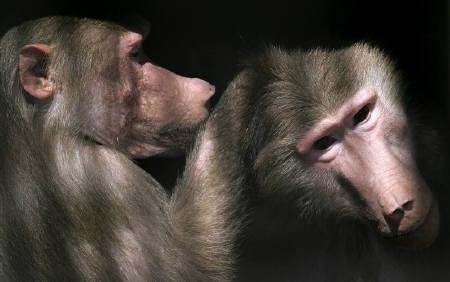Male Baboons Don't Care About Females with Big Butts
| Marco Foronda | | Apr 21, 2015 04:43 AM EDT |
(Photo : REUTERS/NIKOLAY DOYCHINOV/FILES) Hamadryas baboon monkeys check for lice for each other at the zoo in Sofia.
Biologists have long thought that baboon males prefer females with bigger backsides as the mark of a good mother but new research suggests it isn't so simple.
A Duke University study of wild baboons in southern Kenya found the size of the female's behind doesn't have as much of an influence as scientists thought it did.
Like Us on Facebook
Baboons breed throughout the year, and mating occurs during times when a female's behind is swollen, a sign she may be ovulating. For 10 to 20 days each month, the tissue in a female baboon's hindquarters swells up, reaching peak size when a female is most fertile and then shrinking back to normal.
Scientists used a camera technique to monitor the baboons' swelling and mating habits. Measurements from 34 female baboons showed a variation of rump swelling ranging from four to 6.5 inches.
They found this difference in size didn't have an influence on the baboons' mothering abilities or ability to get a mate. Instead of being drawn to females with larger backsides, male baboons tended to prefer females that had cycled more times since their last pregnancy.
The researchers also recorded male courtship behavior during the time when females were swollen. They found that big-bottomed females were no more likely to attract mates than their smaller-bottomed counterparts.
"It's almost as if the males are counting. Our study suggests that, at least in part, males follow a rule along the lines of 'later is better' rather than 'bigger is better,'" said Duke University researcher Courtney Fitzpatrick.
Researchers are also planning to find out if females that have had more postpartum menstrual cycles mate with more males, and whether or not this has an influence on their offspring's chance of survival.
The findings appeared in a recent edition of the journal Animal Behavior.
TagsBaboons Don't Care About Big Butts, Baboons, big butts, butts, baboon pregnancy, postpartum menstrual cycles mate, baboons' mothering abilities, female baboon, male baboon, baboon child bearing, animal mating
©2015 Chinatopix All rights reserved. Do not reproduce without permission
EDITOR'S PICKS
-

Did the Trump administration just announce plans for a trade war with ‘hostile’ China and Russia?
-

US Senate passes Taiwan travel bill slammed by China
-

As Yan Sihong’s family grieves, here are other Chinese students who went missing abroad. Some have never been found
-

Beijing blasts Western critics who ‘smear China’ with the term sharp power
-

China Envoy Seeks to Defuse Tensions With U.S. as a Trade War Brews
-

Singapore's Deputy PM Provides Bitcoin Vote of Confidence Amid China's Blanket Bans
-

China warns investors over risks in overseas virtual currency trading
-

Chinese government most trustworthy: survey
-

Kashima Antlers On Course For Back-To-Back Titles
MOST POPULAR
LATEST NEWS
Zhou Yongkang: China's Former Security Chief Sentenced to Life in Prison

China's former Chief of the Ministry of Public Security, Zhou Yongkang, has been given a life sentence after he was found guilty of abusing his office, bribery and deliberately ... Full Article
TRENDING STORY

China Pork Prices Expected to Stabilize As The Supplies Recover

Elephone P9000 Smartphone is now on Sale on Amazon India

There's a Big Chance Cliffhangers Won't Still Be Resolved When Grey's Anatomy Season 13 Returns

Supreme Court Ruled on Samsung vs Apple Dispute for Patent Infringement

Microsoft Surface Pro 5 Rumors and Release Date: What is the Latest?










